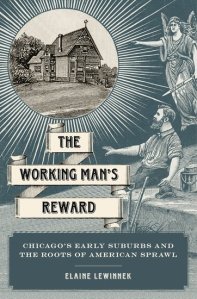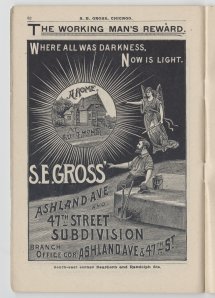
New from Oxford University Press this spring is Elaine Lewinnek’s book on suburbanization in Chicago, The Working Man’s Reward: Chicago’s Early Suburbs and the Roots of American Sprawl.
The author writes:
In my new book, I argue that suburbanization was both a response to industrialization and a resistance to it. Ever since Chicago’s packing companies moved outside the city limits in 1865, workers have been moving outwards to follow the factories, while they also used homes as small businesses, taking in boarders, growing market gardens, and relying on homes as investments that they hoped to control. In 1891, developer Samuel Eberly Gross advertised houses in the shadow of Chicago’s stockyards as “The Working Man’s Reward,” signaling a rewarding space of consumerism after work, yet also a working space that might produce more money, as well as a space that, like the word “worker,” was eventually raced white.
Two riots against suburbanization bookend this story. In 1872, in the wake of the Great Chicago Fire, thousands of working-class immigrants stormed Chicago’s city hall because they were opposed to an early form of zoning that would have pushed small home-owners out of town. Later, in 1919, the residents of the area that Gross had advertised as “The Working Man’s Reward” recognized that they had not received their promised reward and chose to blame African-Americans. This undertow of resistance to suburbanization was not enough to counteract the tide of hopes for upward mobility through property ownership, strategies for domestic respectability imposed from above as well as crafted below, suburbanizing factory locations, the self-provisioning of a working class attempting to resist the vicissitudes of industrial capitalism, and the growth machine of businesses who encouraged Chicago’s sprawl.
Synthesizing the new suburban history, this book also re-periodizes it, looking to earlier metropolitan development to discover what choices were made when various Americans came to identify as homeowners. It was early twentieth-century Chicagoans who helped institutionalize the canard that African-Americans lower property values, in the first realtors’ textbooks of property assessment as well as in scholarly sociological theories, neighborhood “protective” associations, and varied parish politics. I call this the mortgages of whiteness. Through suburban-style property ownership, many European immigrant groups consolidated their whiteness while aligning themselves against blacks.
Chicago’s working-class immigrants helped design the American dream of homeownership, and for some of them, this dream turned into a nightmare. In 1872, anti-suburban rioters blamed city hall, but by 1919, anti-suburban rioters blamed blacks. Collectively, between 1865 and the 1930s, Chicago’s workers, factory-owners, boosters, sociologists, realtors, reformers, urban planners, and novelists all imagined how American cities should grow in suburbs that were always diverse and always contested.
The Working Man’s Reward is available from Oxford, Amazon, and other retailers. Elaine Lewinnek is an associate professor of American Studies California State University, Fullerton. Her web profile is available here.
